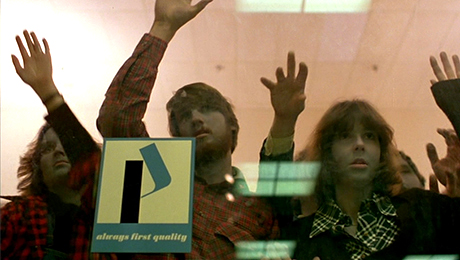By Julyssa Lopez
The last segment of George Romero’s Dawn of the Dead ends in grisly chaos: Thousands of bloodthirsty, carnivorous zombies stagger through a shopping mall, bumping into mannequins and tumbling onto escalators while inching toward three human protagonists who are seeking refuge from the walking dead.
Two of the three outrun the hideous creatures through an office on the top floor, and then manage to board a helicopter waiting above. They escape into a calm sky, leaving behind a mob howling and heaving with hunger for human flesh.
This is where professor Dara Orenstein asks students to pause and think for a moment. There’s more to the scene than simply monsters salivating for gore and guts: Dr. Orenstein observes that the film was released a few years after the official end of the Vietnam War, and that its imagery is expressive of larger concerns in U.S. political culture at the dawn of the Reagan era.
“A helicopter on a roof fleeing desperate hoards, hands and arms outstretched—sound familiar? That’s one of the most famous photographs from the evacuation of Saigon,” she said. She also showed students the trailer for Deerhunter, a blockbuster film from 1978 that was haunted by the war.
Dawn of the Dead is one of nine films and five books that students analyzed this past semester as part of “Zombie Capitalism,” a Dean’s Seminar in the Columbian College of Arts and Sciences. During the American studies course, Dr. Orenstein urged students to peer beyond the zombie’s drooling mouth and vacant eyes to try to decode its deeper meanings.
The class caught rising sophomore Braden Domier’s attention because its title included the word “capitalism.” Zombies and capitalism may seem like two mutually exclusive concepts, but the connection is increasingly common in academia. Scholarly literature in the humanities and beyond boasts a surprising number of articles, essays and even books on how the zombie apocalypse is an allegory for economic and social crises.
A quick glance at Dr. Orenstein’s syllabus reveals an eclectic array of authors, from Zora Neale Hurston and Barry Goldwater to the political scientist Daniel Drezner and the novelists Colson Whitehead and George Saunders. Starting with White Zombie from 1932, students tracked how the figure of the zombie evolved over the 20th century.
“The zombie emerged in the United States at the height of the Depression as a commentary on assembly-line work,” Dr. Orenstein said. “The zombie is, first and foremost, a soulless body that performs rote, repetitive labor. And, in the 1930s, for a nation still defined by Jim Crow, it was significant that this zombie hailed from sugar plantations in Haiti. It raised the specter of slavery as much as of so-called wage slavery.”
One pattern students noticed was that “the” zombie is never a singular figure. Unlike the charismatic monsters Dracula and Frankenstein, the zombie attacks in crowds.
“It’s a metonymy for the masses, the multitude—for labor, that is, not for capital,” Dr. Orenstein said,
Dr. Orenstein started teaching at GW this year, after earning her Ph.D. in American studies at Yale University. She structured the class as a seminar so that students could experiment in wide-ranging, open-ended discussions with the task of “how to use the folklore of the zombie to denaturalize the folklore of capitalism,” she explained.
For each meeting she assigned two “scribes” to take notes, which they later posted to a Google Doc, which other students then amended and elaborated, thereby creating a “transcript” of the ideas birthed over the course of the semester.
“My hope has been for this class to be interdisciplinary in the best sense, challenging students not only to grapple with themes that matter to a variety of disciplines but also to reflect on how those disciplines variously process those themes,” she said.
Adding that her colleagues were extremely encouraging as she crafted the syllabus, she noted that it’s a perfect fit for American studies, combining cultural and historical analysis, or, for example, George Romero and Karl Marx.
In the final unit, students followed the zombie out of the sugar mill and into the cubicle, looking at more recent films like World War Z, Shaun of the Dead and Zombieland, as well as Mr. Whitehead’s novel “Zone One.” Mr. Domier found that analyzing the genealogy of the zombie up to the present was one of the most thought-provoking aspects of the class.
“We started with the zombie’s origins in Haiti, all the way to contemporary culture, where the zombie is presented in more comedic ways,” he said. “That was a really interesting change to see over time.”
Looming over the entire semester was a famous remark from cultural theorist Frederic Jameson: “It is easier to imagine the end of the world than to imagine the end of capitalism.” Although Dr. Orenstein confessed that she has never paid much heed to science fiction, preferring the critical realism of TV shows like The Wire and Breaking Bad, she explained that she has come to regard the zombie genre as uniquely illuminating—no idea is too ridiculous or off-limits when it comes to zombies.
“Zombies are unthinkable, and yet uncannily resonant,” she said. “They embody our worst fears and, arguably, some of our secret hopes, too.”


